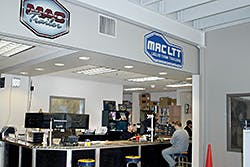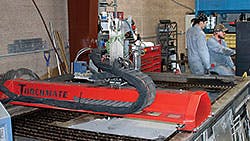Utah Tank & Trailer uses fabrication capability to provide exactly the right parts for repair jobs
CUSTOM parts fabrication is a specialty that helps Utah Tank & Trailer stand out from the competition as a cargo tank repair shop. In-house parts making capability helps enable a faster turn-around for trailer repair jobs.
Located in West Valley, Utah, on the west side of Salt Lake City, the shop has a National Board R-stamp for code tank repairs, and technicians work on a wide range of equipment from dump trailer to propane transports. More than half of the technicians are qualified as code welders.
“We take in a lot of specialized tank repair jobs here, and customers keep coming back because we do what they want,” says Barry McKenzie, general manager of Utah Tank & Trailer. “We have a very talented team of technicians and fabricators in this operation. The repair work they turn out is almost always better than the original tank.
“This operation has grown into one of the largest tank parts and repair facilities west of the Mississippi River. We’ve been in business for approximately 16 years. In addition to the repair services, Utah Tank & Trailer is a dealer for Mac Trailer and Mac LTT.
“Last year was one of our busiest years to date. We provided repaired and serviced more than 3,000 cargo tanks in 2015, and we did a lot of fabrication work. Tank testing and inspection accounted for 20% to 25% if the service work.”
The facility covers 65,000 square feet on five acres. It has 18 drive-through bays that are 135 feet long. Spanning those bays are two overhead five-ton bridge cranes. Another 14,000-sq-ft is devoted to warehousing approximately $1.8 million in parts needed to repair just about any type of trailer.
A key part of the shop is the fabrication area. Equipment includes a 12-inch shear, two 12-ft press brakes, and 12-ft rolls. Two of the most distinctive machines in the fab shop are a lathe and a 10-ft water plasma high-definition cutting table that give the shop the capability to turn out customized parts in a short amount of time.
Utah Tank & Trailer bought the plasma cutter about three years ago. The machine can cut through a variety of electrically conductive materials, including steel, aluminum, brass, and copper. Plasma is created by heating a gas or subjecting it to a strong electromagnetic field applied with a laser or microwave generator.
Plasma cutting appealed to the tank repair shop management because it offers the ability to make high-speed, precision metal cuts with relatively low cost of operation.
“We use the plasma cutter and the lathe to make parts that we need right away,” McKenzie says. “The plasma cutter can duplicate factory parts or be used to make our own specialty parts. Every tank trailers seems like it is constructed a bit differently and parts often must be customized to fit properly.
“When it comes to general tank parts, we primarily use the plasma cutter when we need to meet a deadline or can’t find something through regular sources. If part can be ordered and delivered quickly, we’ll have it shipped. After all, it costs more to make a part in house.”
The custom parts making capability was especially useful over the past several years when the shop was assembling a lot of equipment for oilfield customers. Some of this equipment required a lot of custom fabrication.
Beyond the typical cargo tank and trailer parts, the plasma cutter makes it possible to provide specialized items that are custom fabricated—such as nameplates cut out of steel or aluminum plate. ♦
About the Author
Charles Wilson
Editor
Charles E. Wilson has spent 20 years covering the tank truck, tank container, and storage terminal industries throughout North, South, and Central America. He has been editor of Bulk Transporter since 1989. Prior to that, Wilson was managing editor of Bulk Transporter and Refrigerated Transporter and associate editor of Trailer/Body Builders. Before joining the three publications in Houston TX, he wrote for various food industry trade publications in other parts of the country. Wilson has a bachelor's degree in journalism from the University of Kansas and served three years in the U.S. Army.







